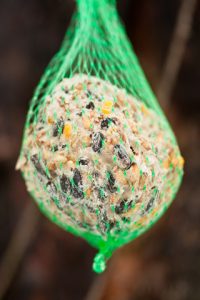Winter Bird Feeding
December 13, 2018
As the self-proclaimed “bird nerd” here at A & M Insurance, I wanted to chirp in about some bird feeding tips for the back-yard bird enthusiast or simply those who’d like to help out the little winged beauties in the winter months when food is more scarce and harder to find.

Birds feeding on a suet cake in winter. ID 84033814 © Manon Ringuette | Dreamstime.com
The majority of birds are insect eaters and have to switch to searching for seeds and fruits during the winter. Our feathered friends may face hardships when locating wild food sources due to human activities. Cities and towns may have removed trees and shrubs. Development in urban and rural areas is causing wildlife to have more difficulty in finding food and shelter.
Just like people, birds have a preference for different foods. Towhees, Juncos, Sparrows and Finches enjoy white millet and black oil sunflower seeds. Woodpeckers, Stellar Jays, Chickadees, Bushtits, Nuthatches, Wrens and Starlings love to eat suet.
I have a few feeders on my property that I try to keep stocked with bird suet. Typically bird suet balls or blocks are composed of beef kidney fat. The fats in suet provides birds a great alternate source of high energy food when they need it most, and helps them stay warm. I try to buy bird suet cakes when they are on sale, however, you can also make your own. I actually find this more rewarding and a lot of fun!
If you feel so inclined, supplemental feeding can help our little friends and may also add abundant personal enjoyment and even a sense of well being to your own life.
You can get suet at your butcher or grocery store meat counter. In my experience it is often very inexpensive and sometimes even free.
Here are a couple of my simple recipes on how to make bird suet blocks:

Suet ball in mesh bag.
ID 12993655 © Cornelia Pithart | Dreamstime.com
Basic formula
• Heat to boiling 1-part suet and 6 parts water.
• Add 2 parts cornmeal, 1/2-part flour, 1-part brown sugar.
• Cool, pour into cupcake molds or a parchment lined pan, or empty tuna fish cans, and allow to harden. If you are using a parchment lined cake pan then once it solidifies you can cut it into smaller blocks to size to fit your feeders.
Tracey’s Suet Cake
• Twice melt 2 parts suet, allowing it to harden between melts.
• Blend in 1-part yellow cornmeal and 1-part (no sugar or salt added) peanut butter.
• Allow to thicken, pour into molds or a parchment lined pan, allow to harden. Cool, pour into cupcake molds or a parchment lined pan, or empty tuna fish cans, and allow to harden. If you are using a parchment lined cake pan then once it solidifies you can cut it into smaller blocks to size to fit your feeders.
The relative proportions of these ingredients may vary depending on your preferences. You can also add in seeds such as sunflower and/or fruits like dried unsweetened cranberries, dates, apricots, oranges, raisins, blueberries or cherries.
Remember to refrigerate any leftover mixture.
Locate suet feeders at least five feet from the ground and close to a tree trunk. Most birds that enjoy suet are cling feeders; they cling to tree trunks in search of insects so the close proximity to the tree will encourage suet feeding. Since suet is a coveted item, it is eaten rapidly once birds discover it. You will need to refill feeders often, especially in the winter. You can present suet in a cage feeder or specially made feeder. You can also simply place it inside a mesh bag, or simply rub it directly onto tree trunks and branches. You can even put suet balls on a fruit spike or skewer. Birds will find it. Before long, you will see a steady stream of birds eagerly visiting your suet feeders.
Tracey Bartel- Bird Nerd
Info used from WA Dept of Fish and Wildlife